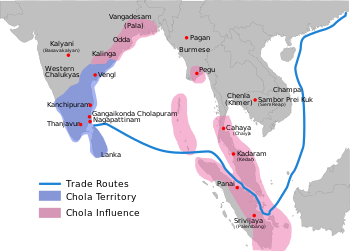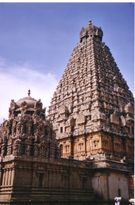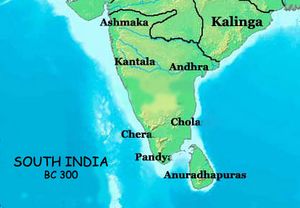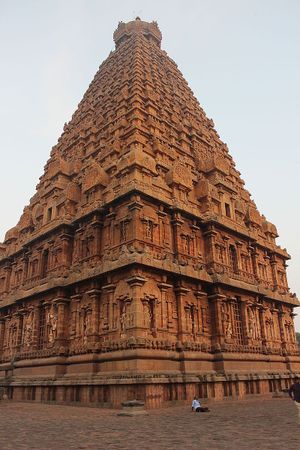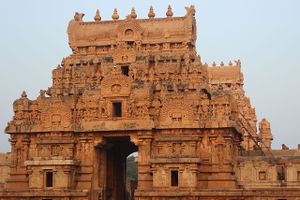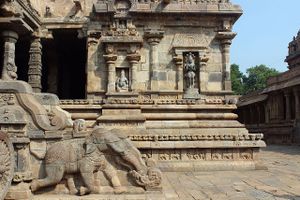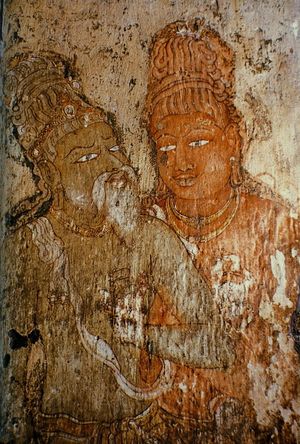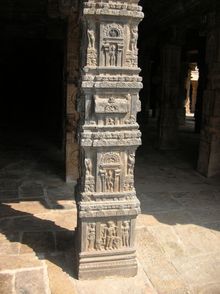أسرة تشولا
| |||||||||||||||||||||||||||||||||||||||||||||||||||||||||||||
| |||||||||||||||||||||||||||||||||||||||||||||||||||||||||||||
| |||||||||||||||||||||||||||||||||||||||||||||||||||||||||||||
أسرة تشولا Chola dynasty كانت واحدة من أطول الأسر الحاكمة عمراً في تاريخ جنوب الهند. أقدم إشارات قابلة للتأريخ لهذه الأسرة الحاكمة من التاميل توجد في نقوش من القرن الثالث ق.م. تركها أشوكا من امبراطورية موريا. كأحد الملوك الثلاثة المتوجين على تاميلاكام، فقد استمرت الأسرة في الحكم على مساحة متغيرة من الأرض حتى القرن 13 الميلادي.
The heartland of the Cholas was the fertile valley of the Kaveri River, but they ruled a significantly larger area at the height of their power from the later half of the 9th century till the beginning of the 13th century. The whole country south of the Tungabhadra was united and held as one state for a period of two centuries and more.[4] Under Rajaraja Chola I and his successors Rajendra Chola I, Rajadhiraja Chola, Virarajendra Chola and Kulothunga Chola I the dynasty became a military, economic and cultural power in South Asia and South-East Asia.[5] The power of the new empire was proclaimed to the eastern world by the expedition to the Ganges which Rajendra Chola I undertook and by the naval raids on cities of the maritime empire of Srivijaya, as well as by the repeated embassies to China.[6] The Chola fleet represented the zenith of ancient Indian sea power.
During the period 1010–1153, the Chola territories stretched from the islands of the Maldives in the south to as far north as the banks of the Godavari River in Andhra Pradesh.[7] Rajaraja Chola conquered peninsular South India, annexed parts of which is now Sri Lanka and occupied the islands of the Maldives. Rajendra Chola sent a victorious expedition to North India that touched the river Ganges and defeated the Pala ruler of Pataliputra, Mahipala. He also successfully invaded cities of Srivijaya of Malaysia and Indonesia.[8] The Chola dynasty went into decline at the beginning of the 13th century with the rise of the Pandyan Dynasty, which ultimately caused their downfall.[9][10]
The Cholas left a lasting legacy. Their patronage of Tamil literature and their zeal in the building of temples has resulted in some great works of Tamil literature and architecture.[5] The Chola kings were avid builders and envisioned the temples in their kingdoms not only as places of worship but also as centres of economic activity.[11][12] They pioneered a centralised form of government and established a disciplined bureaucracy. The Chola school of art spread to Southeast Asia and influenced the architecture and art of Southeast Asia.[13][14]
الأصول
The Cholas are also known as the Choda.[15] There is very little information available in regarding their origin. Its antiquity is evident from the mentions in ancient Tamil literature and in inscriptions. Later medieval Cholas also claimed a long and ancient lineage. Mentions in the early Sangam literature (c. 150 CE)[أ] indicate that the earliest kings of the dynasty antedated 100 CE. Cholas were mentioned in Ashokan Edicts of 3rd Century BCE as one of the neighboring countries existing in the South.[بحاجة لمصدر]
A commonly held view is that Chola is, like Chera and Pandya, the name of the ruling family or clan of immemorial antiquity. The annotator Parimelazhagar said: "The charity of people with ancient lineage (such as the Cholas, the Pandyas and the Cheras) are forever generous in spite of their reduced means". Other names in common use for the Cholas are Killi (கிள்ளி), Valavan (வளவன்) and Sembiyan (செம்பியன்). Killi perhaps comes from the Tamil kil (கிள்) meaning dig or cleave and conveys the idea of a digger or a worker of the land. This word often forms an integral part of early Chola names like Nedunkilli, Nalankilli and so on, but almost drops out of use in later times. Valavan is most probably connected with "valam" (வளம்) – fertility and means owner or ruler of a fertile country. Sembiyan is generally taken to mean a descendant of Shibi – a legendary hero whose self-sacrifice in saving a dove from the pursuit of a falcon figures among the early Chola legends and forms the subject matter of the Sibi Jataka among the Jataka stories of Buddhism.[16] In Tamil lexicon Chola means Soazhi or Saei denoting a newly formed kingdom, in the lines of Pandya or the old country.[17]
There is very little written evidence available of the Cholas prior to the 7th century. Historic records exist thereafter, including inscriptions on temples. During the past 150 years, historians have gleaned significant knowledge on the subject from a variety of sources such as ancient Tamil Sangam literature, oral traditions, religious texts, temple and copperplate inscriptions. The main source for the available information of the early Cholas is the early Tamil literature of the Sangam Period.[ب] There are also brief notices on the Chola country and its towns, ports and commerce furnished by the Periplus of the Erythraean Sea (Periplus Maris Erythraei), and in the slightly later work of the geographer Ptolemy. Mahavamsa, a Buddhist text written down during the 5th century CE, recounts a number of conflicts between the inhabitants of Ceylon and Cholas in the 1st century BCE.[19] Cholas are mentioned in the Pillars of Ashoka (inscribed 273 BCE–232 BCE) inscriptions, where they are mentioned among the kingdoms which, though not subject to Ashoka, were on friendly terms with him.[ت]

التشولا الامبراطوريون
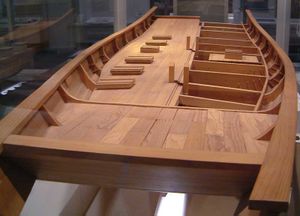
The Western Chalukya Empire under Satyashraya and Someshvara I tried to wriggle out of Chola domination from time to time, primarily due to the Chola influence in the Vengi kingdom.[22]
الفتوحات وراء البحار
During the reign of Rajaraja Chola I and his successors Rajendra Chola I, Virarajendra Chola and Kulothunga Chola I the Chola armies invaded Sri Lanka, the Maldives and parts of Southeast Asia like Malaysia, Indonesia and Southern Thailand[23] of the Srivijaya Empire in the 11th century. Rajaraja Chola I launched several naval campaigns that resulted in the capture of Sri Lanka, Maldives and the Malabar Coast.[24] In 1025, Rajendra Chola launched naval raids on ports of Srivijaya and against the Burmese kingdom of Pegu.[25] A Chola inscription states that he captured or plundered 14 places, which have been identified with Palembang, Tambralinga and Kedah among others.[26] A second invasion was led by Virarajendra Chola, who conquered Kedah in Malaysia of Srivijaya in the late 11th century.[27]
التشولا اللاحقون (1070–1279)
الادارة والمجتمع
الحكم
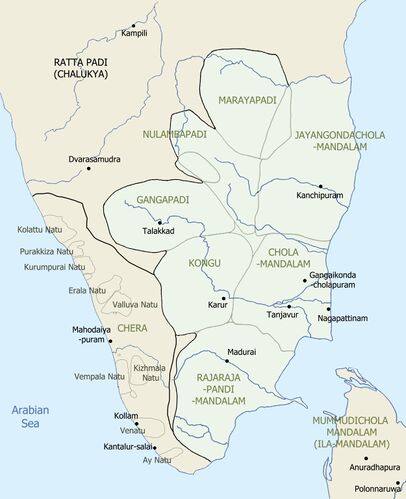
في عصر التشولا، اتحد كل جنوب الهند لأول مرة تحت حكومة واحدة.[ث]
التجارة الخارجية
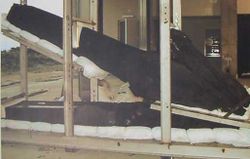
الاسهامات الثقافية
الفن
الأدب
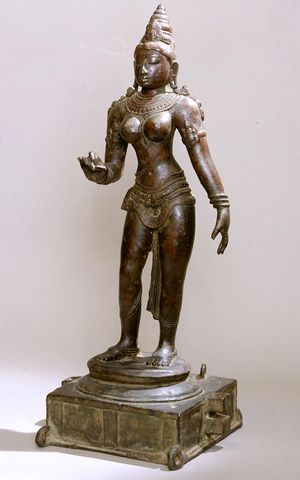
The Imperial Chola era was the golden age of Tamil culture, marked by the importance of literature. Chola records cite many works, including the Rajarajesvara Natakam, Viranukkaviyam and Kannivana Puranam.[28]
The revival of Hinduism from its nadir during the Kalabhras spurred the construction of numerous temples and these in turn generated Shaiva and Vaishnava devotional literature.[29] Jain and Buddhist authors flourished as well, although in fewer numbers than in previous centuries.[30] Jivaka-chintamani by Tirutakkatevar and Sulamani by Tolamoli are among notable works by non-Hindu authors.[31][32][33] The grammarian Buddhamitra wrote a text on Tamil grammar called Virasoliyam.[34] Commentaries were written on the great text Tolkāppiyam which deals with grammar but which also mentions ethics of warfare.[35][36][37]
الدين
انظر أيضاً
الهامش
ملاحظات
- ^ The age of Sangam is established through the correlation between the evidence on foreign trade found in the poems and the writings by ancient Greek and Romans such as Periplus. K.A. Nilakanta Sastri, A History of Cyril and Lulu Charles, p 106
- ^ The period covered by the Sangam poetry is likely to extend not longer than five or six generations.[18]
- ^ The Ashokan inscriptions speak of the Cholas in plural, implying that, in his time, there were more than one Chola.[20]
- ^ الوقت الآخر الوحيد حين اتحدت كل شبه القارة الهندية تحت مظلة واحدة قبل استقلال الهند كان عهد امبراطورية ڤيجايانگرا (1336–1614).[بحاجة لمصدر]
الهامش
- ^ David Shulman (2016). Tamil. Harvard University Press. p. 150. ISBN 978-0-674-97465-4.
One thing, however, is certain: the Cholas were happy to use Tamil as an official state language, along with Sanskrit...
- ^ A History of Ancient and Early Medieval India: From the Stone Age to the 12th Century (2008), Upinder Singh, p. 559.
- ^ John N. Miksic 2013, p. 79.
- ^ K.A. Nilakanta Sastri, A History of South India, p 157
- ^ أ ب Keay, p 215
- ^ K.A. Nilakanta Sastri, A History of South India, p 158
- ^ Majumdar (contains no mention of Maldives)
- ^ Meyer, p 73
- ^ K.A. Nilakanta Sastri, A History of South India, p 195
- ^ K.A. Nilakanta Sastri, A History of South India, p 196
- ^ Vasudevan, pp 20–22
- ^ Keay, pp 217–218
- ^ Thai Art with Indian Influences by Promsak Jermsawatdi p.57
- ^ Columbia Chronologies of Asian History and Culture by John Stewart Bowman p.335
- ^ Prasad (1988), p. 120
- ^ Sastri (1984), pp. 19–20
- ^ Archaeological News A. L. Frothingham, Jr. The American Journal of Archaeology and of the History of the Fine Arts, Vol. 4, No. 1 (Mar., 1998), pp. 69–125
- ^ Sastri (1984), p. 3
- ^ Columbia Chronologies of Asian History and Culture by John Bowman p.401
- ^ Sastri (1984), p. 20
- ^ Chopra, Ravindran & Subrahmanian (2003), p. 31
- ^ Sastri (2002), p. 158
- ^ Between 2 Oceans (2nd Edn): A Military History of Singapore from 1275 to 1971 by Malcolm H. Murfett, John Miksic, Brian Farell, Chiang Ming Shun p.16
- ^ South India by Stuart Butler, Jealous p.38
- ^ Asia: A Concise History by Arthur Cotterell p.190
- ^ Paine (2014), p. 281
- ^ History of Asia by B.V. Rao p.211
- ^ Sastri (1984), pp. 663–664
- ^ Sastri (2002), p. 333
- ^ Sastri (2002), p. 339
- ^ Chopra, Ravindran & Subrahmanian (2003), p. 188
- ^ Sastri (2002), pp. 339–340
- ^ Ismail (1988), p. 1195
- ^ Ancient India: Collected Essays on the Literary and Political History of southern India by Sakkottai Krishnaswami Aiyangar p.127
- ^ The Princeton Encyclopedia of Poetry and Poetics by Roland Greene, Stephen Cushman, Clare Cavanagh, Jahan Ramazani, Paul F. Rouzer, Harris Feinsod, David Marno, Alexandra Slessarev p.1410
- ^ Singh (2008), p. 27
- ^ Portraits of a Nation: History of Ancient India, by Kamlesh Kapur p.617
ببليوجرافيا
- Barua, Pradeep (2005), The State at War in South Asia, University of Nebraska Press, ISBN 978-0-80321-344-9
- Chopra, P. N.; Ravindran, T. K.; Subrahmanian, N. (2003), History of South India: Ancient, Medieval and Modern, S. Chand & Company Ltd, ISBN 81-219-0153-7
- Das, Sisir Kumar (1995), History of Indian Literature (1911–1956): Struggle for Freedom – Triumph and Tragedy, Sahitya Akademi, ISBN 81-7201-798-7
- Dehejia, Vidya (1990), The Art of the Imperial Cholas, Columbia University Press
- Devare, Hema (2009), "Cultural Implications of the Chola Maritime Fabric Trade with Southeast Asia", in Kulke, Hermann; Kesavapany, K.; Sakhuja, Vijay, Nagapattinam to Suvarnadwipa: Reflections on the Chola Naval Expeditions to Southeast Asia, Institute of Southeast Asian Studies, ISBN 978-9-81230-937-2
- Eraly, Abraham (2011), The First Spring: The Golden Age of India, Penguin Books, ISBN 978-0-67008-478-4
- Gough, Kathleen (2008), Rural Society in Southeast India, Cambridge University Press, ISBN 978-0-52104-019-8
- Harle, J. C. (1994), The art and architecture of the Indian Subcontinent, Yale University Press, ISBN 0-300-06217-6
- Hellmann-Rajanayagam, Dagmar (2004), "From Differences to Ethnic Solidarity Among the Tamils", in Hasbullah, S. H.; Morrison, Barrie M., Sri Lankan Society in an Era of Globalization: Struggling To Create A New Social Order, SAGE, ISBN 978-8-13210-320-2
- Jermsawatdi, Promsak (1979), Thai Art with Indian Influences, Abhinav Publications, ISBN 978-8-17017-090-7
- Kulke, Hermann; Rothermund, Dietmar (2001), A History of India, Routledge, ISBN 0-415-32920-5
- Lucassen, Jan; Lucassen, Leo (2014), Globalising Migration History: The Eurasian Experience, BRILL, ISBN 978-9-00427-136-4
- Majumdar, R. C. (1987) [1952], Ancient India, Motilal Banarsidass Publications, ISBN 81-208-0436-8
- John N. Miksic (2013). Singapore and the Silk Road of the Sea, 1300_1800. NUS Press. ISBN 978-9971-69-558-3.
{{cite book}}: Invalid|ref=harv(help) - Mitter, Partha (2001), Indian art, Oxford University Press, ISBN 0-19-284221-8
- Mukherjee, Rila (2011), Pelagic Passageways: The Northern Bay of Bengal Before Colonialism, Primus Books, ISBN 978-9-38060-720-7
- Mukund, Kanakalatha (1999), The Trading World of the Tamil Merchant: Evolution of Merchant Capitalism in the Coromandel, Orient Blackswan, ISBN 978-8-12501-661-8
- Mukund, Kanakalatha (2012), Merchants of Tamilakam: Pioneers of International Trade, Penguin Books India, ISBN 978-0-67008-521-7
- Nagasamy, R. (1970), Gangaikondacholapuram, State Department of Archaeology, Government of Tamil Nadu
- Nagasamy, R. (1981), Tamil Coins – A study, Institute of Epigraphy, Tamil Nadu State Dept. of Archaeology
- Paine, Lincoln (2014), The Sea and Civilization: A Maritime History of the World, Atlantic Books, ISBN 978-1-78239-357-3
- Prasad, G. Durga (1988), History of the Andhras up to 1565 A. D., P. G. Publishers
- Rajasuriar, G. K. (1998), The history of the Tamils and the Sinhalese of Sri Lanka
- Ramaswamy, Vijaya (2007), Historical Dictionary of the Tamils, Scarecrow Press, ISBN 978-0-81086-445-0
- Rothermund, Dietmar (1993), An Economic History of India: From Pre-colonial Times to 1991 (Reprinted ed.), Routledge, ISBN 978-0-41508-871-8
- Sadarangani, Neeti M. (2004), Bhakti Poetry in Medieval India: Its Inception, Cultural Encounter and Impact, Sarup & Sons, ISBN 978-8-17625-436-6
- Sakhuja, Vijay; Sakhuja, Sangeeta (2009), "Rajendra Chola I's Naval Expedition to South-East Asia: A Nautical Perspective", in Kulke, Hermann; Kesavapany, K.; Sakhuja, Vijay, Nagapattinam to Suvarnadwipa: Reflections on the Chola Naval Expeditions to Southeast Asia, Institute of Southeast Asian Studies, ISBN 978-9-81230-937-2
- Sastri, K. A. N. (1984) [1935], The CōĻas, University of Madras
- Sastri, K. A. N. (2002) [1955], A History of South India: From Prehistoric Times to the Fall of Vijayanagar, Oxford University Press
- Scharfe, Hartmut (2002), Education in Ancient India, Brill Academic Publishers, ISBN 90-04-12556-6
- Schmidt, Karl J. (1995), An Atlas and Survey of South Asian History, M.E. Sharpe, ISBN 978-0-76563-757-4
- Sen, Sailendra Nath (1999), Ancient Indian History and Civilization, New Age International, ISBN 978-8-12241-198-0
- Sen, Tansen (2009), "The Military Campaigns of Rajendra Chola and the Chola-Srivija-China Triangle", in Kulke, Hermann; Kesavapany, K.; Sakhuja, Vijay, Nagapattinam to Suvarnadwipa: Reflections on the Chola Naval Expeditions to Southeast Asia, Institute of Southeast Asian Studies, ISBN 978-9-81230-937-2
- Singh, Upinder (2008), A History of Ancient and Early Medieval India: From the Stone Age to the 12th Century, Pearson Education India, ISBN 978-8-13171-120-0
- South Indian Inscriptions, What Is India Publishers (P) Ltd, http://www.whatisindia.com/inscriptions/, retrieved on 2008-05-30
- Spuler, Bertold (1975), Handbook of Oriental Studies, Part 2, BRILL, ISBN 978-9-00404-190-5
- Stein, Burton (1980), Peasant state and society in medieval South India, Oxford University Press
- Stein, Burton (1998), A history of India, Blackwell Publishers, ISBN 0-631-20546-2
- Subbarayalu, Y. (2009), "A Note on the Navy of the Chola State", in Kulke, Hermann; Kesavapany, K.; Sakhuja, Vijay, Nagapattinam to Suvarnadwipa: Reflections on the Chola Naval Expeditions to Southeast Asia, Institute of Southeast Asian Studies, ISBN 978-9-81230-937-2
- Thapar, Romila (1995), Recent Perspectives of Early Indian History, South Asia Books, ISBN 81-7154-556-4
- Tripathi, Rama Sankar (1967), History of Ancient India, Motilal Banarsidass, ISBN 81-208-0018-4
- Talbot, Austin Cynthia (2001), Pre-colonial India in Practice: Society, Region, and Identity in Medieval Andhra, Oxford University Press, ISBN 978-0-19803-123-9
- Vasudevan, Geeta (2003), Royal Temple of Rajaraja: An Instrument of Imperial Cola Power, Abhinav Publications, ISBN 81-7017-383-3
- Wolpert, Stanley A (1999), India, University of California Press, ISBN 0-520-22172-9
وصلات خارجية
قالب:Chola dynasty topics قالب:Tribes and kingdoms of the Mahabharata
| الممالك الوسطى في الهند | ||||||
|---|---|---|---|---|---|---|
| خط زمني والفترة التاريخية |
Northwestern India | Indo-Gangetic Plain | الهند الوسطى | الهند الجنوبية | ||
| Upper Gangetic Plain | Middle Gangetic Plain
|
Lower Gangetic Plain
| ||||
| العصر الحديدي | ||||||
| الثقافة | فترة الڤديك المتأخرة | فترة الڤديك المتأخرة (Brahmin ideology)[أ] |
فترة الڤديك المتأخرة (Kshatriya/Shramanic culture)[ب] |
ما قبل التاريخ | ||
| القرن 6 ق.م. | گاندارا | كورو-Panchala | ماگادا | أديڤاسي (قبائل) | ||
| الثقافة | التأثير الفارسي-اليوناني | "التمدن الثاني" | ما قبل الهند | |||
| القرن 5 ق.م. | (الحكم الفارسي) | Shishunaga dynasty | أديڤاسي (قبائل) | |||
| القرن 4 ق.م. | (الغزوات اليونانية) | امبراطورية ناندا | ||||
| العصر التاريخي | ||||||
| الثقافة | انتشار البوذية | ما قبل التاريخ | Sangam period (300 ق.م. – 200 م) | |||
| القرن 3 ق.م. | امبراطورية مورايا | Early Cholas 46 other small kingdoms in Ancient Thamizhagam | ||||
| الثقافة | الهندوسية ما قبل الكلاسيكية[ت] - "Hindu Synthesis"[ث] (ca. 200 BC - 300 AD)[ج][ح] الملاحم - Puranas - Ramayana - Mahabharata - Bhagavad Gita - Brahma Sutras - Smarta Tradition Mahayana Buddhism |
Sangam period (استمرت) | ||||
| القرن 2 ق.م. | المملكة الهندو-يونانية | امبراطورية شونگا | Early Cholas 46 ممالك أخرى صغيرة في Ancient Thamizhagam | |||
| القرن 1 ق.م. | ||||||
| القرن 1 م | مملكة كونيندا | |||||
| القرن 2 | امبراطورية كوشان | |||||
| القرن 2 | المملكة الكوشانية الساسانية | امبراطورية كوشان | Western Satraps | Kamarupa kingdom | Kalabhra dynasty | |
| الثقافة | "العصر الذهبي للهندوسية"(ح. 320-650 م)[خ] Puranas Co-existence of Hinduism and Buddhism | |||||
| القرن 4 | Kidarites | Gupta Empire | Kalabhra dynasty | |||
| القرن 5 | Hephthalite Empire | Alchon Huns | Kalabhra dynasty | |||
| القرن 6 | Nezak Huns | Maitraka | Adivasi (tribes) | Badami Chalukyas | ||
| الثقافة | Late-Classical Hinduism (ح. 650-1100 م)[د] Advaita Vedanta - Tantra Decline of Buddhism in India | |||||
| القرن 7 | Indo-Sassanids | Vakataka dynasty Empire of Harsha |
Mlechchha dynasty | Adivasi (tribes) | Pandyan Kingdom(Under Kalabhras) | |
| القرن 8 | Kabul Shahi | Pala Empire | Pandyan Kingdom | |||
| القرن 9 | Gurjara-Pratihara | Rashtrakuta dynasty | ||||
| القرن 10 | Ghaznavids | Pala dynasty | Kalyani Chalukyas | |||
مصادر ومراجع الجدول المصادر Sources
| ||||||
- Articles with unsourced statements from April 2015
- Harv and Sfn no-target errors
- Articles with hatnote templates targeting a nonexistent page
- Missing redirects
- Portal-inline template with redlinked portals
- Pages with empty portal template
- Articles with unsourced statements from April 2017
- أسرة تشولا
- Chola Empire
- Dynasties of India
- Hindu dynasties
- Empires and kingdoms of India
- History of Thanjavur
- دول وأقاليم تأسست في the 4th century BC
- القرن الرابع ق.م.
- انحلالات 1279 في آسيا
- States and territories disestablished in the 1270s
- القرن 13 في آسيا
- ساحل كوروماندل
- ملوك تاميل
